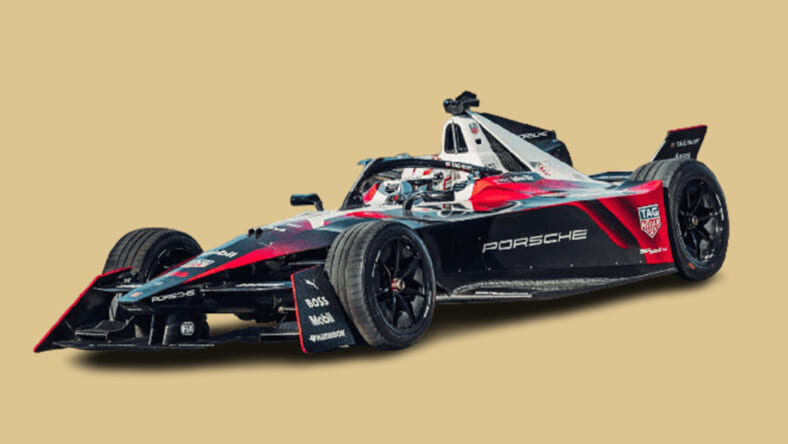A Closer Look At The Porsche 99X Gen3 Formula E Car
The 99X Gen3 Electric might just be the most complete toy Porsche has ever created. For the ninth season of […]

The 99X Gen3 Electric might just be the most complete toy Porsche has ever created.
For the ninth season of the ABB FIA Formula E World Championship racing series, launching on January 14th, 2023, in Mexico City, the teams participating shall see all-new cars. In a prestigious event at Porsche’s newly opened Performance Center in Franciacorta, Italy, the team became the first in the industry to unveil its new racer, dubbed the 99X. The rules for Formula E have been continually evolving for quite some time. Beyond the obvious cosmetic changes, which are undoubtedly noticeable, this year brings some pretty significant changes under the skin too.
The biggest difference is that they have added an additional motor up front. However, this motor cannot drive the wheels to move the car. Formula E takes advantage of the regenerative braking system to help add additional braking power, which becomes extremely critical in competition. All in all, this new Porsche is faster, lighter, and more powerful than ever, but unfortunately or fortunately, it is exclusively for racetracks.
The Pole Position
There are two motors for Porsche’s Gen3 99X racer and one for the rear motor. This means that the car has a recuperation potential of 600 kW, 250 kW coming from one and 350 kW from the other. It would be more than 2.4 times more regenerative power than the 250 kW of its Gen2. In Formula E racing, power recovery is one of the most critical factors. With the proper driving techniques and strategy to recover energy, the cars may be able to finish the race.
Porsche has provided regenerative braking power that is capable of recovering up to 600 kW during the race. More than 40 percent of the energy consumed to drive the 99X will be recovered during the race by regenerative braking power. Another huge benefit of the vehicle accepting the massive power is that if it becomes necessary to pit, the car will be able to charge itself with 4 to 5 kWh in a 30-second charge boost if needed.
There is a motor at the front axle as well, which does not drive the wheels, but rather it is a motor that drives the axle. The 99X can generate a total of 600 kW, of which 250 kW is recuperated at the front, and 350 kW is recuperated at the rear. Unlike traditional cars, the Gen3 cars do not have rear brakes at the rear. Except for the electric motor’s regeneration phase, there is no other reason for slowing down the back wheels.
There is a specific rear drive motor, gearbox, differential, and all the software that runs on the vehicle. These are specific to each team, along with the rear subframe and the vehicle’s various parts.
This new generation of racers comes with a smaller battery capacity of 38.5 kilowatt-hours, which is down from 52 kilowatt-hours in the previous generation. With these changes, the upcoming vehicles can be lighter and more agile due to these weight savings.
A Modern-Day Racer
The 99X looks more like a modern open-wheel motor vehicle than a traditional open-wheel race car. There are no more large fairings covering the wheels of the car’s front end. On the nose, the wing has a more complex shape with multiple planes and long endplates that give it a more imposing appearance. In the rear, there are tall, angled sections of bodywork and a low wing located along the vehicle’s sides.
The series rules stipulate that each car will have a shorter wheelbase and a narrower track than its predecessor to create a more competitive series. The vehicles now weigh a minimum of 1,852 lbs, down from 1,984 pounds when the previous generation was introduced.
By scoring 134 points in the previous season, the Tag Heuer Porsche Formula E team finished in seventh place and positioned itself in the top 10. Mercedes EQ took the top spot in the standings after scoring 319 points in the last race.
Prioritizing Sustainability
It is an equally vital part of Formula E that sustainability is also of the utmost importance. The third generation of Formula E cars utilizes battery cells manufactured using sustainably sourced minerals, and the battery cells are reused or recycled after each season. Each Formula E car is constructed out of recycled carbon fiber, and even its bodywork is built from carbon fiber. This helps Formula E to reduce its carbon footprint.
Along with the body being made from recycled materials, the tires of this machine are also constructed from recycled materials. Natural rubber and recycled fibers will make up over 25% of the rubber used in the upcoming Gen3 race cars. After every race, the used tires will also be recycled to make new ones so the cycle can continue.
In any motorsport event where a Porsche is on track, it builds high hopes for its fans. With the 99X Gen3, Porsche raises that bar to another level. From its design to the punch it packs under the hood, the vehicle is exhilarating, to say the least.
